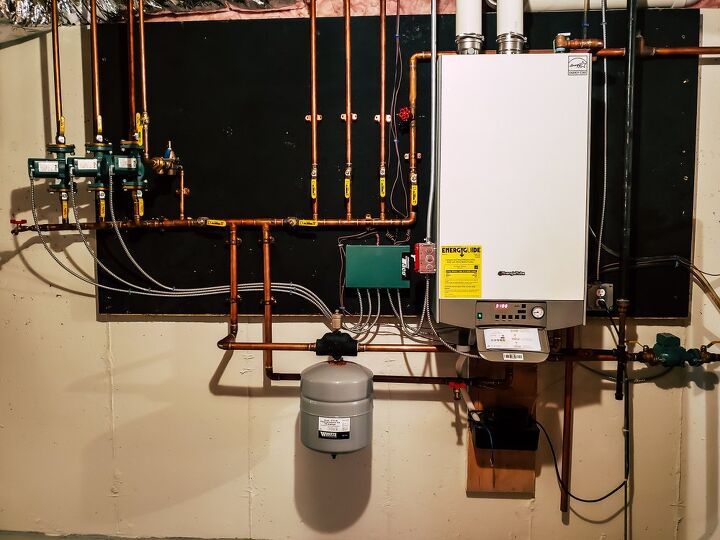How Long Does It Take To Fill A 40 Gallon Water Heater?

Your water heater is a far more valuable appliance than you may have even realized. Sure, hot water sounds like a basic convenience but you don’t realize how important it is. Not until you step into the shower, turn the dial to hot, and get that icy blast of water.
So, if you have a 40-gallon water heater, you may need to troubleshoot the issue. You may find that you simply need to refill the water heater. If that is the case, then you are looking at around 30 to 40 minutes to fully fill the water heater. Provided there are no other issues, you should be able to use your water heater as normal again.
Do You Need Water Heater Repair Services?
Get free, zero-commitment quotes from pro contractors near you.

How Big is a 40-Gallon Water Heater?
The size of your water heater can play a factor in your troubleshooting efforts. Part of having an efficient (and working) water heater is ensuring that it is the right size. A smaller water heater will have to work a lot harder for a family, for instance, wearing down far sooner.
A 40-gallon water heater is considered to be on the small side. That’s fine for anywhere from one to three people. The next up is about 80 gallons, which is considered medium. Finally, a large water heater is about 100 gallons and is meant to serve four to six people.
That said, the most common capacities when it comes to water heaters are between 40 and 60 gallons. For the most part, homes only have two adults. When kids grow to be teens, it may be better to upgrade to a larger water heater for more consistent, even water heating.
The Speedy of Recovery
One of the most important aspects of your water heater is known as the recovery time. The recovery time of a water heater is how much time it takes for the heater to reheat the entire water supply in the tank.
The speed of recovery typically comes down to whether you have an electric or gas model. Gas water heaters take half the time of an electric unit, for instance. They are also a little more expensive, so there is a caveat.
The average 40-gallon gas water heater will recover in an hour or less. The same-sized electric water heater will take around two hours to fully recover.
When Replacement May Be Needed
Depending on the age and condition of the water heater, the recovery time can skew. If you have a water heater that leaves you waiting for hot water more often than not, it may be time to either replace the current unit with another of the same size or upgrade to a larger water heater.
Tankless water heaters are becoming a more common option because they only heat water as is needed. It all depends on what your costs are to not only buy but install the new water heater. Take your family’s water-heating needs into consideration as well.
How to Fill Your Water Heater
Now that you have a better idea of how long it will take to fill your 40-gallon water heater, it is time to learn how to fill it. It might sound easy but it really is quite a bit more complicated than you realize. Follow these steps to fill your water heater up in a safe, efficient manner.
Step 1: Safety First
Whenever you perform maintenance or repairs of any kind on your water heater, safety should come first. Even if it seems like common sense, make sure that the power to your water heater is disconnected.
Far too many people forget this step and wind up in a lot of trouble. Water is a natural electrical conductor, which means it is quite harmful to touch water that has been infused with electricity. If you have a natural gas water heater, turn off the gas valve before proceeding.
Step 2: Drain Out Any Remaining Water
Even if you think your water heater has been fully drained, there is likely residual water resting at the bottom of the tank. You want to clear this out before you begin refilling the tank once again. Make sure that the cold-water valve is closed in preparation and be aware of how long it takes to fill your water heater before moving on.
From here, connect the hose directly to a drainage valve. This will drain any remaining water in the tank either directly outdoors or down a drain. Be diligent and ensure that you remove any water remaining in the tank.
This part is important because it prevents potential complications within the water supply and the water heater as well. Make sure that any time you refill the water heater, you flush the remaining water. It is a good process that helps to ensure the longevity of the water heater. When done, close your drainage valve and put the hose back into its original place.
Step 3: Filling with Cold Water
When you are certain that the old water has been flushed away, it is time for the next step. Open up your hot water faucet. The good news is that you are already halfway to refilling your water heater again.
This step depends on the available water pressure in your home. Water has to be clean to ensure that it is safe for use for the entire household. Make sure that you check out and test the water pressure before you start filling. Water that is unclean can be a huge waste of energy. Should you have a constant, steady flow of water, then you can go ahead and close the valve again.
Step 4: Turn the Power Back On
When the water heater is full of water once again, it is time to turn the power (or gas) back on. Make sure that you connect any of the essential plugs or wires to begin the restoration process (refer to the timetable above).
The good news is that you can do this process whenever is most comfortable. If you have some errands to do, that is a simple way to pass the time. You can even do this before bed so that you have hot water waiting when you wake up.
Step 5: Check the Drainage Valve
This is a step that is far too often ignored. Don’t just assume that all is good after refilling and restoring your water heater. Check the drainage valve after you have restored the power to ensure that it is working properly.
You can also perform this step prior to reconnecting the wires or plugs. It will all help ensure that your water heater runs as it should. Ensure that your drainage valve has been properly tightened. That will ensure that you don’t have problems with leaking.
Do You Need Water Heater Repair Services?
Get free, zero-commitment quotes from pro contractors near you.

Take Your Time
The most important thing to do when refilling your water heater is to take your time. While it may seem like a relatively simple process, it is all too easy for things to go awry. Make sure to take proper safety measures and ensure that all connections (like the drainage valve) are properly sealed.
When you are done, you should find that your water heater functions normally again. If it doesn’t, or the hot water dissipates quickly again, you may want to consider upgrading your unit. Either a newer model or a larger one may be required depending on your living situation, usage, and other factors. Take time to reassess the issue if you are experiencing lasting problems with getting hot water.
Related Articles

Ryan Womeldorf has more than a decade of experience writing. He loves to blog about construction, plumbing, and other home topics. Ryan also loves hockey and a lifelong Buffalo sports fan.
More by Ryan Womeldorf



























